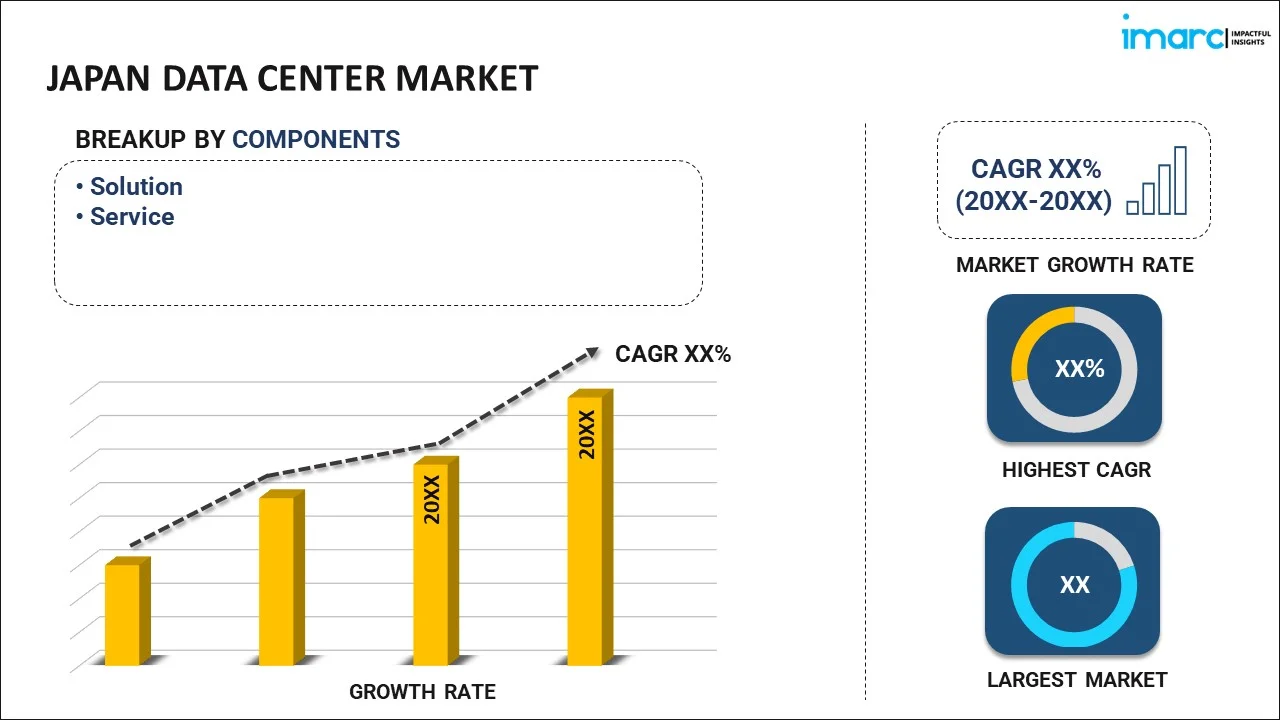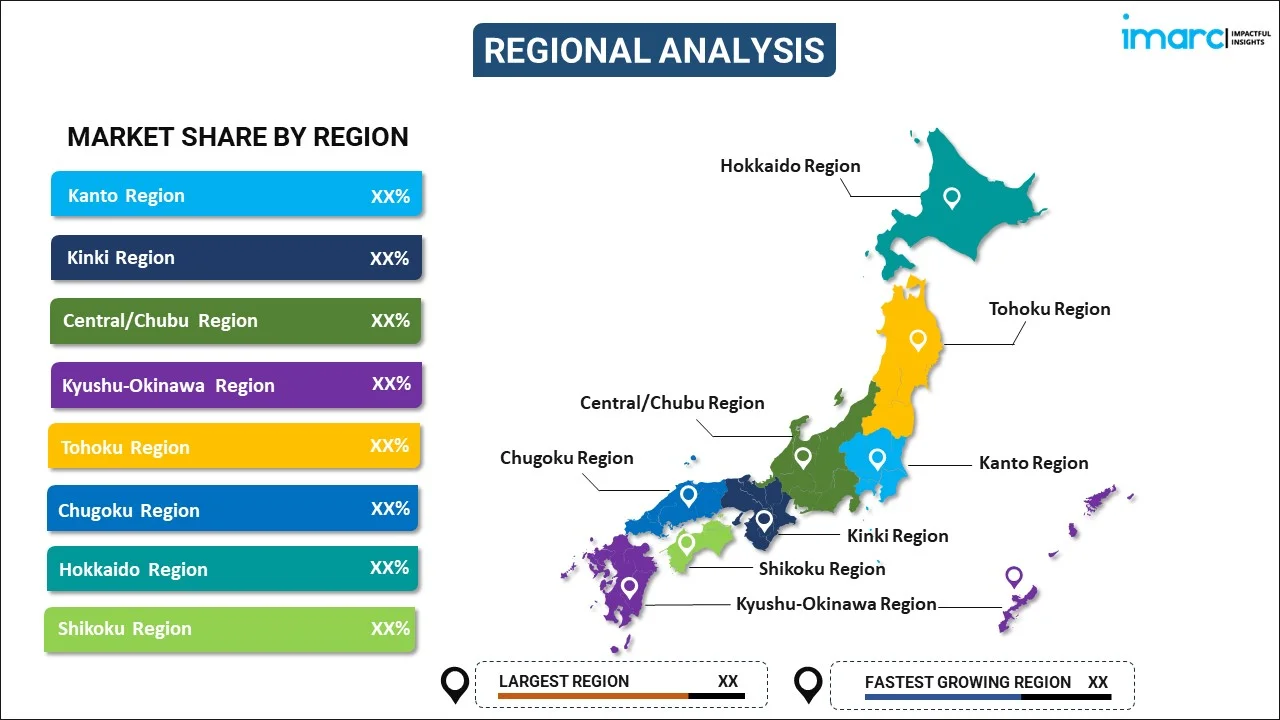
Japan Data Center Market Report by Component (Solution, Services), Type (Colocation, Hyperscale, Edge, and Others), Enterprise Size (Large Enterprises, Small and Medium Enterprises), End User (BFSI, IT and Telecom, Government, Energy and Utilities, and Others), and Region 2025-2033
Market Overview:
The Japan data center market size reached 1.37 GW in 2024. Looking forward, IMARC Group expects the market to reach 2.12 GW by 2033, exhibiting a growth rate (CAGR) of 4.99% during 2025-2033. The increasing demand for cloud services and big data analytics, the rising need for more reliable and scalable data processing and storage facilities and stringent regulatory compliance represent some of the key factors driving the market.
|
Report Attribute
|
Key Statistics
|
|---|---|
|
Base Year
|
2024 |
|
Forecast Years
|
2025-2033 |
|
Historical Years
|
2019-2024
|
| Market Size in 2024 | 1.37 GW |
| Market Forecast in 2033 | 2.12 GW |
| Market Growth Rate (2025-2033) | 4.99% |
A data center refers to a central location where data and information are kept, managed, and shared. It is an essential part of computing technology that is essential to how businesses run on a regular basis. It houses an organization's most vital and proprietary assets, such as computer systems, telecommunications, and storage systems. It consists of various physical and virtual components, including servers, routers, switches, and firewalls, providing a seamless network for processing and transferring data. Additionally, it is equipped with redundant power supplies, data communications connections, and environmental controls to ensure uninterrupted service. The architecture of a data center is designed to be robust and scalable, meeting the ever-growing demands for data processing and storage. Security measures are rigorously implemented to safeguard against unauthorized access and data breaches. In today's digital age, data centers are indispensable to businesses, governments, and other entities that rely on data processing and IT services. It supports online transactions and web services and enables cloud computing, big data analytics, and various applications that drive innovation and growth in the modern economy. A data center's efficiency, reliability, and security are paramount in ensuring that the technology infrastructure performs optimally.
Japan Data Center Market Trends:
The Japan data center industry is experiencing significant growth, driven by the increasing demand for cloud services and big data analytics among enterprises and government organizations. The need for more reliable and scalable data processing and storage facilities is being fueled by the development of Internet of Things (IoT) devices and Artificial Intelligence (AI) applications. Japan's strategic position in the global economy, coupled with its strong focus on technology and innovation, has led to a rise in investments by both domestic and international companies in the data center industry. The government's commitment to digital transformation and initiatives, including Society 5.0, which aims to create a human-centric society through the integration of cyberspace and physical space, plays a vital role in stimulating industry growth. Another significant driver is the need for disaster recovery and business continuity planning. Japan's geographical location, which makes it prone to natural disasters, including earthquakes and tsunamis, has led organizations to invest in highly resilient data center infrastructure to ensure uninterrupted operations. In addition, the rise in remote working trends, accelerated by recent global events, has further increased the demand for data center services. This shift emphasizes the need for secure and reliable data access, thereby driving investments in the expansion and modernization of data center. Apart from this, environmental concerns and the pursuit of sustainability are also influencing the industry's direction. Japan's data centers progressively adopt energy-efficient technologies and practices to minimize environmental impact. The commitment to green computing aligns with the nation's broader goals of reducing carbon emissions and contributes to the industry's attractiveness to socially responsible investors. Furthermore, stringent regulatory compliance and data sovereignty requirements are shaping the Japan data center market. With accelerating concerns over data privacy and security, the need for localized data handling and storage is growing.
Japan Data Center Market Segmentation:
IMARC Group provides an analysis of the key trends in each segment of the Japan data center market report, along with forecasts at the country level for 2025-2033. Our report has categorized the market based on component, type, enterprise size, and end user.
Component Insights:

- Solution
- Services
The report has provided a detailed breakup and analysis of the market based on the component. This includes solution and service.
Type Insights:
- Colocation
- Hyperscale
- Edge
- Others
A detailed breakup and analysis of the market based on the type have also been provided in the report. This includes colocation, hyperscale, edge, and others.
Enterprise Size Insights:
- Large Enterprises
- Small and Medium Enterprises
The report has provided a detailed breakup and analysis of the market based on the enterprise size. This includes large enterprises, and small and medium enterprises.
End User Insights:
- BFSI
- IT and Telecom
- Government
- Energy and Utilities
- Others
A detailed breakup and analysis of the market based on the end user have also been provided in the report. This includes BFSI, IT and telecom, government, energy and utilities, and others.
Regional Insights:

- Kanto Region
- Kinki Region
- Central/ Chubu Region
- Kyushu-Okinawa Region
- Tohoku Region
- Chugoku Region
- Hokkaido Region
- Shikoku Region
The report has also provided a comprehensive analysis of all the major regional markets, which include Kanto Region, Kinki Region, Central/ Chubu Region, Kyushu-Okinawa Region, Tohoku Region, Chugoku Region, Hokkaido Region, and Shikoku Region.
Competitive Landscape:
The report has also provided a comprehensive analysis of the competitive landscape in the market. Competitive analysis such as market structure, key player positioning, top winning strategies, competitive dashboard, and company evaluation quadrant has been covered in the report. Also, detailed profiles of all major companies have been provided. The companies in the market are adopting various strategic initiatives including new product launches and business alliances to gain a significant Japan data center market share.
Japan Data Center Market Report Coverage:
| Report Features | Details |
|---|---|
| Base Year of the Analysis | 2024 |
| Historical Period | 2019-2024 |
| Forecast Period | 2025-2033 |
| Units | GW |
| Scope of the Report | Exploration of Historical and Forecast Trends, Industry Catalysts and Challenges, Segment-Wise Historical and Predictive Market Assessment:
|
| Components Covered | Solution, Service |
| Types Covered | Colocation, Hyperscale, Edge, Others |
| Enterprise Sizes Covered | Large Enterprises, Small and Medium Enterprises |
| End Users Covered | BFSI, IT And Telecom, Government, Energy and Utilities, Others |
| Regions Covered | Kanto Region, Kinki Region, Central/ Chubu Region, Kyushu-Okinawa Region, Tohoku Region, Chugoku Region, Hokkaido Region, Shikoku Region |
| Customization Scope | 10% Free Customization |
| Post-Sale Analyst Support | 10-12 Weeks |
| Delivery Format | PDF and Excel through Email (We can also provide the editable version of the report in PPT/Word format on special request) |
Key Questions Answered in This Report:
- How has the Japan data center market performed so far and how will it perform in the coming years?
- What has been the impact of COVID-19 on the Japan data center market?
- What is the breakup of the Japan data center market on the basis of component?
- What is the breakup of the Japan data center market on the basis of type?
- What is the breakup of the Japan data center market on the basis of enterprise size?
- What is the breakup of the Japan data center market on the basis of end user?
- What are the various stages in the value chain of the Japan data center market?
- What are the key driving factors and challenges in the Japan data center?
- What is the structure of the Japan data center market and who are the key players?
- What is the degree of competition in the Japan data center market?
Key Benefits for Stakeholders:
- IMARC’s report offers a comprehensive quantitative analysis of various market segments, historical and current market trends, market forecasts, and dynamics of the Japan data center market from 2019-2033.
- The research study provides the latest information on the market drivers, challenges, and opportunities in the Japan data center market.
- Porter's five forces analysis assist stakeholders in assessing the impact of new entrants, competitive rivalry, supplier power, buyer power, and the threat of substitution. It helps stakeholders to analyze the level of competition within the Japan data center industry and its attractiveness.
- Competitive landscape allows stakeholders to understand their competitive environment and provides an insight into the current positions of key players in the market.
Need more help?
- Speak to our experienced analysts for insights on the current market scenarios.
- Include additional segments and countries to customize the report as per your requirement.
- Gain an unparalleled competitive advantage in your domain by understanding how to utilize the report and positively impacting your operations and revenue.
- For further assistance, please connect with our analysts.
 Inquire Before Buying
Inquire Before Buying
 Speak to an Analyst
Speak to an Analyst
 Request Brochure
Request Brochure
 Request Customization
Request Customization




.webp)




.webp)












